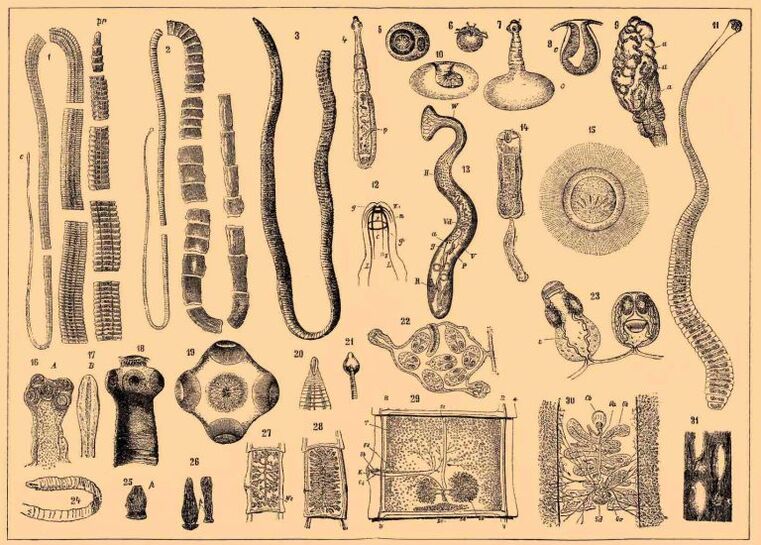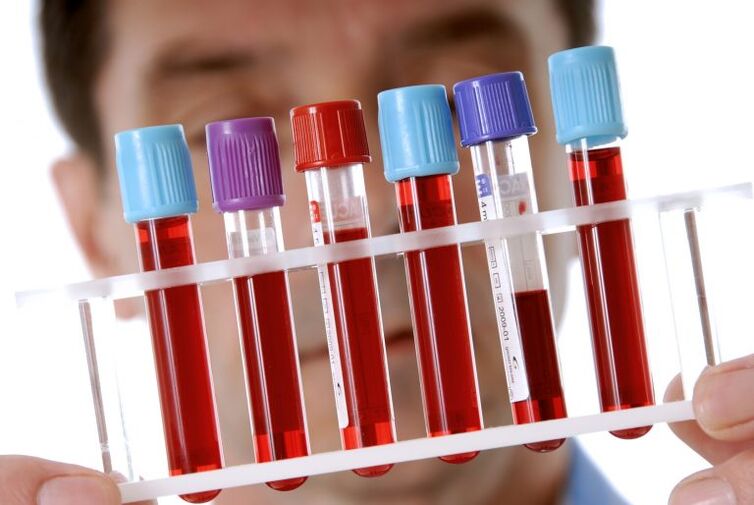Various scientific studies have confirmed the association of many pathological conditions in humans with parasitic diseases. In humans, worms often do not show any characteristic symptoms of the disease, so they can remain in the body for many years, causing dangerous complications and pathologies. Sometimes the only sign of a parasitic disease may be black dots in the stool or light-colored helminth eggs and worms in the stool. A diagnosis must be made to determine if there are worms in the human body. First of all, they study feces, so it is important to know what worms look like in human feces, as well as to understand the types of parasites in humans. In addition to the types of parasites, our article will describe the symptoms of worms in humans and ways to diagnose parasitic diseases.
Symptoms of worms in humans

From the photo, it is easy to understand what worm eggs look like in the feces and in the worms themselves. The different worms in a person in the photo can vary significantly. Some egg worms or adults are so small that other parasites in the feces and their eggs can be seen without a microscope. Therefore, when answering the question of whether eggs can be seen with the naked eye, it is necessary to take into account which worms live in humans.
Eggs are not always visible in the stool, and sometimes the only symptoms of helminthiasis may be the following:
- lose weight;
- general weakness;
- often there is rapid fatigue;
- the skin becomes pale;
- itching in the anal region.
However, worm larvae or some symptoms of the disease caused by adults do not even associate with sick worms. These symptoms include:
- flatulence, diarrhea and constipation;
- nausea and vomiting;
- pain in the navel and right hypochondrium.
When such symptoms appear, it is first necessary to study the fecal mass. In this case, the smallest eggs of worms can be found in the feces. Since worm eggs are difficult to self-identify, it is best to send the feces to a laboratory for analysis. Only an expert knows what worm eggs look like.
Sometimes there are no parasites in the stool, but the patient has general signs of intoxication. When parasitic toxins affect the human nervous system, the following symptoms of the disease appear:
- dizziness;
- tiredness;
- Headache;
- increased irritability;
- drowsiness;
- depression;
- convulsions;
- temperature rise.

If worms and their eggs are found in a child's feces, the symptoms of the disease are often complemented by various allergic manifestations:
- urticaria, dermatitis;
- skin rashes;
- itchy skin, redness.
Worms in the feces of adults or children can be detected only at a certain stage of the disease, and not always. Therefore, it is not important to know what parasitic larvae look like, because it is necessary to understand the symptoms of a particular parasitic disease:
- Pinworms, which cause enterobiasis, usually cause severe itching in the anal area, which worsens at night. This is because these nematodes (roundworms) crawl out of the anus and lay their eggs in the perianal folds.
- Anemia and beriberi will be characteristic symptoms of hookworm, diphyllobotriasis and trichuriasis.
- The symptomatology of ascariasis depends on the stage of development of the helminth. At the stage of migration, the clinical picture is expressed by a complex of symptoms from the respiratory system (shortness of breath, cough, bronchitis, pneumonia). Symptoms characteristic of gastrointestinal pathologies appear in the intestinal phase. In this case, black spots may appear in the stool.
- Trichinosis causes fever, swelling of the face and muscle pain.
- If the trematodes are located in the liver, pancreatitis develops, jaundice of the sclera and skin is visible, the spleen is enlarged. With this form of the disease, the stool masses may not have black threads and spots.
- Schistosomiasis causes bleeding in the genitourinary system, so urine may be mixed with blood. The parasite often causes indigestion.
Types of worms

In the photo, the worms in a person can vary greatly depending on their particular species. This means that tapeworms and roundworms are parasitic on the human body. The helminths of the same variety in the photo may also differ. So, roundworms include pinworms, nematodes, trichinella, roundworms, hookworms. There are two classes of flatworms:
- cestodes (pigs and cattle tapeworm, exinococcus, broad tapeworm, alveococcus);
- trematodes (including schistosomes, opisthorchias, paragonyms).
You can learn what this or that helminth looks like in the photo. We will describe the features of the existence of the main parasites of the human body:
- Symptoms of pinworms provoke enterobiasis, which appears on the third day after infection. Eggs enter the body with unwashed hands, fruits and herbs.
- Vlasoglav causes a disease called trichuriasis. Its first symptoms may appear 21-35 days after the invasion. Infection occurs when cooking in unsanitary conditions. Usually the patient suffers from diarrhea, anorexia, abdominal pain. This may be an inflammation of the appendix.
- The culprit of diphyllobotriasis is a wide tapeworm. The disease manifests itself 2-5 weeks after infection. The parasite enters the body with a weakly fried fish that has been infected. This helminth can live in the human body for decades, causing anemia, beriberi, intestinal obstruction, allergies and intoxication.
- Roundworms are the culprits of ascariasis. When infected with these worms, black spots may appear in the feces of adults and children. It lasts from the moment of occupation to the appearance of the clinical picture for up to three months. The parasite enters the intestines with plant foods.
- Roundworm - The corn worm stimulates the corn worm. Infection can occur while working on the ground, walking barefoot on the ground. The disease manifests itself 5-8 days after infection. First, there is itching and swelling where the parasite penetrates, then cough with abundant sputum, dizziness, weakness.
- Huge hepatic obstruction causes fascioliasis. The parasite enters the body through contaminated water and plant foods. The first signs of the disease may appear 0. 5-1 months after the onset of the invasion. The disease manifests itself with a dry cough, fever, abdominal pain and loss of appetite.
- A worm called Trichinella is the cause of trichinosis in humans. Helminths can enter the human body through poorly processed meat and fat. The first symptoms appear two days after infection. The patient usually suffers from diarrhea, heartburn and nausea.
Diagnosis of helminthiasis

When many helminthiases are diagnosed, the stool is examined first. If you find black dots in the stool or white worms in the stool, this test should be done as soon as possible.
However, stools with only black dots are not an indicator for a coprogram. Even invisible eggs can be easily identified under a microscope. More accurate diagnosis of fecal masses for the detection of helminth DNA particles is made using PCR.
If a person has a lot of blackheads in his stool, among other diagnostic methods, the following should be noted:
- abrasion in the area near the anus;
- Blood test by ELISA, PCR, RNGA and other methods;
- Make sure you do blood biochemistry and CLA;
- In some cases, ultrasound, MRI and CT are performed to determine the location of parasites;
- X-ray examination is performed to diagnose the migration stage of helminths.
In certain forms of helminthiasis, the composition of sputum, rectal mucus, urine and gallbladder can be studied. Endoscopic examination is also sometimes used in the diagnosis.




























